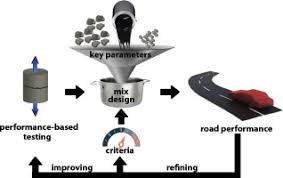This report presents the findings of the NCDOT
Project RP2022-06, which evaluated the performance of asphalt mixtures that
were used in two construction projects. Laboratory testing was conducted on
RS9.5C, RI19.0C, and RB25.0C asphalt mixtures to assess fundamental performance
metrics, including resistance to cracking and rutting using Asphalt Mixture Performance
Tester as well as balanced mix design tests.
The study evaluated the impact of
variations in binder content and air voids on asphalt mixture performance,
revealing apparent performance differences across samples. The study
investigated the impact of short-term aging protocols and found that using two
hours instead of four hours for short-term aging yields better agreement
between lab-mixed lab-compacted and plant-mixed lab-compacted samples. This
finding is essential for improving the accuracy of laboratory predictions and
aligning them more closely with real-world performance. Index-volumetrics
relationships and performance-volumetrics relationships were calibrated and
verified, providing essential tools for predicting the performance of quality control/quality assurance
samples and evaluating material behavior under different conditions.

The project also determined aging model coefficients for the included mixtures, enabling the incorporation of aging effects in pavement performance simulations. Pavement performance simulations were performed using FlexPAVETM version 2.2 software and the results highlighted the importance of intermediate and base mixtures on the full-depth asphalt performance. Sapp and RSI values were predicted by inputting QC/QA data to the developed IVR functions. The predicted index values showed that RS9.5C remained within the Standard traffic tier, RI19.0C met the Standard tier for Sapp but variable tiers for RSI (10% Standard, 64% Heavy, 18% Very Heavy, 8% Extremely Heavy), and 23% of RB25.0C samples fell below Standard tier according to Sapp values.
Additionally, the report provides a framework for assessing the impact of current tolerance limits for binder content and in-place density on fatigue and rutting performance. Based on the QMS limits, the 95% confidence intervals for Sapp across all three mixtures remained within the Standard traffic tier, while RSI confidence intervals varied, with RS9.5C spanning Standard to Heavy and RI19.0C ranging from Heavy to Extremely Heavy. This framework can be applied to a more representative sample size of North Carolina asphalt mixtures to develop recommendations for amending the current Quality Management System limits. These findings contribute to optimizing quality control measures and improving the long-term performance of North Carolina’s highway infrastructure.
